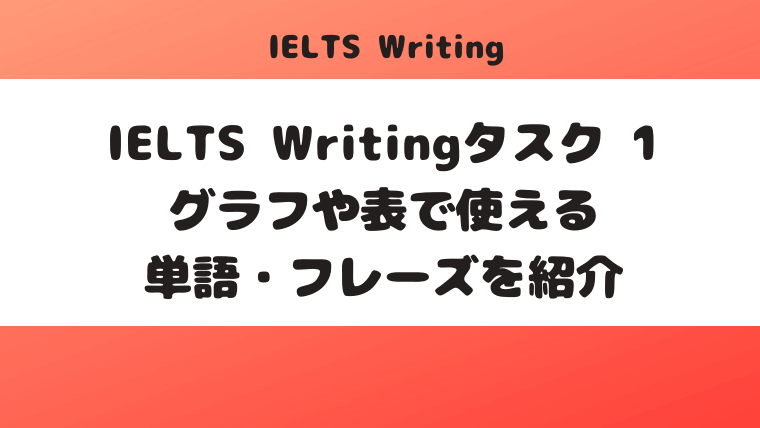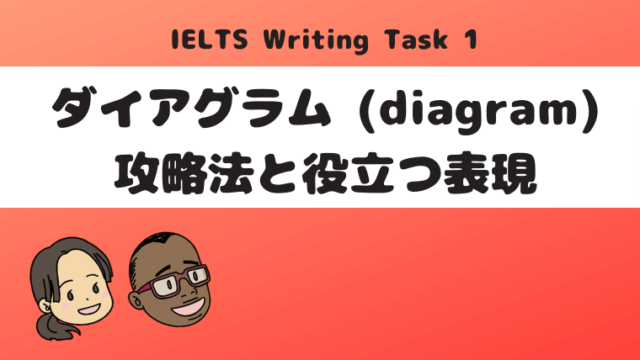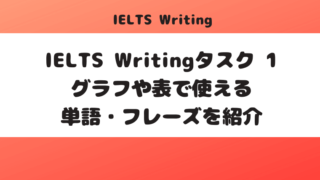イントロ(冒頭)で使える単語・フレーズ
ここではIELTS Writing Task1のイントロで使える主語(名詞)と動詞を紹介します。まずは問題文の置き換えを行います。
たくさんパターンがありすぎても迷うので、問題文と違うものだけを使うことを意識しましょう。
問題文置き換えの構成:(名詞)×(動詞)×(グラフの内容)
問題文:The bar chart below shows the percentage of Australian men and women in different age groups who did regular physical activity in 2010.
置き換え後:The graph illustrates the proportion of Australian people who exercise regularly by age and gender in 2010.
| 置き換えに使える主語 | 使い方 |
|---|---|
| The figure | The figure shows how many people travelled overseas. |
| The number of | The number of children joining the football team in 2010 and 2020. |
| The graph | The graph shows the comparison of waste disposal in Canada and America. |
| The diagram | The diagram illustrates the process of changing the seasons from summer to winter. |
| 置き換えに使える動詞 | 使い方 |
|---|---|
| show | The diagram shows the materials that go into the production of concrete. |
| illustrate | The diagram illustrates the process of cement manufacture. |
| compare | The line graph compares three types of traveller visiting New Zealand between 1997 and 2017 |
注意点としては、主語が単数形の場合「show」となり動詞に「s」がつきますが、主語が複数形の場合は動詞は原型のまま使います。
まとめ(Overview)で使えるフレーズ
まとめを書くときの単語は、迷わないことがポイントです。迷っていると脳のリソースと時間を使ってしまうことになります。
毎回同じエッセイを書いていると飽きがくると思いますが、この2つの単語どちらかを使うことをおすすめします。
| まとめに使える表現 | 意味 | 使い方 |
|---|---|---|
| In conclusion | 概要として | In conclusion, the principal change to the town will be the construction of a ring road around the centre. |
| It is clear that | ~なことは明らかだ | It is clear that the majority of Americans ate in fast food restaurants between once a week and once a month in all three years. |
パラグラフ内の基本構造
IELTS Writingタスク1では主にふたつの文章を使って構成されていきます。その文章構造に追加して副詞や前置詞で内容を表すのが一般的です。
- カテゴリー(1):動詞で状態を表現する方法
例:The rate of emergency care attendants increased slightly. - カテゴリー(2):形容詞・名詞で状態を表現する方法
例:There was a slight increase in the rate of emergency care attendants.
このカテゴリー(1)・(2)も同じ文章です。IELTS Writingタスク1では文法の知識というのが採点基準に含まれているため、IELTS6.5を獲得するためにはこの2つのパターンをマスターする必要があります。
カテゴリー(1)動詞で状態を表現する方法
高得点を取るための文章構造としては、動詞のあとに副詞で変化の程度を表す必要があります。
(名詞)×(動詞)×(副詞)×(副詞)
| フレーズ | 意味 | 使い方 |
|---|---|---|
| The proportion | 割合 | The proportion of mobile phone owners who recorded videos on their phones rose by 26%, from 9% to 35% between 2008 and 2010. |
| The ratio | 割合 | The ratio of patients in the hospital remained the same, compared to the last year. |
| The percentage | 割合 | The percentage of smokers in England decreased dramatically since 2014. |
| The figure | 図 | The figures show teen obesity is on the rise. |
| The number | 数 | The number of vegetarians in America doubled since 2000. |
| The graph | グラフ | The graph fluctuated widely in 2005, then remained flat after 2006. |
増加を表す動詞
| 動詞 | 意味 | 使い方 |
|---|---|---|
| increase | 増える | Over the following five or six years, spending by all three types of traveller increased dramatically. |
| rise | 増える | Daily spending had risen to approximately $250, $210 and $140 respectively for vacationers. |
| go up | 上がる | The number of people who eat fast-food went up to 40% in Mexico. |
| double | 2倍 | The number of unemployed people doubled between 2005 and 2009. |
減少を表す動詞
| 動詞 | 意味 | 使い方 |
|---|---|---|
| fell | 落ちる | The proportion of guests who considered the hotel’s customer service to be poor fell from 21% in 2005 to only 12% in 2010. |
| drop | 落ちる | The proportion of people who thought customer service was very poor dropped from 15% to only 4% over the 5-year period. |
| decrease | 減る | Over the next 3 years, sales of video games decreased by more than half. |
| reduce | 減る | Korea was the only country that managed to reduce its waste output by the year 2000. |
その他(回復・同じ・ブレ)
| 単語 | 意味 | 使い方 |
|---|---|---|
| recover | 回復する | The number of elderly people in Japan dropped by 3% in 2005 before recovering to the same levels in 2010. |
| level off | 横ばいになる | The number of people who write letters by hand levelled off in 2004 |
| fluctuate | 上下変動する | The percentage of supplement takers fluctuated. |
カテゴリー(2):形容詞・名詞で状態を表現する方法
主語は先程イントロで紹介した「置き換えに使える主語」を利用するパターンと「There was~」で始める表現の2通りがあります。この文章を使うときのポイントとしては装飾として使われる形容詞が名詞の前にくるということです。
(名詞)×(動詞)×(形容詞)×(名詞)
まずは置き換えに使える主語に続く述語を紹介します。
| 単語・フレーズ | 使い方 |
|---|---|
| showed | The graph showed a significant decrease. |
| experienced | Australian man experienced a dramatic increase. |
| saw | The proportion of smokers saw a quick fall. |
| There was a | There was a sudden change between A and B. |
増加を表す名詞
| 単語 | 使い方 |
|---|---|
| increase | The number of pubs in England experienced a gradual increase of 7% over the last 2 years. |
| rise | The number of shoppers in big companies saw a quick rise from 2,000 to 70,000 in 5 years. |
| growth | There was a constant growth for people who eat out in 2015, compared to them in 2000. |
減少を表す名詞
| 単語 | 使い方 |
|---|---|
| decrease | The number of British people who watched TVs experienced a significant decrease in 2001. |
| fall | There was an abrupt fall in numbers of workers who served in the factory. |
| drop | The number of waterfalls showed a considerable drop over the last 5 decades. |
変化の程度を表す副詞・形容詞
| 意味 | 副詞 | 形容詞 |
| 常に | constantly | constant |
| 速く | quickly | quick |
| 速く | rapidly | rapid |
| 急に | sharply | sharp |
| 急に | suddenly | sudden |
| 急に | steeply | steep |
| 激しく | drastically | drastic |
| 激しく | dramatically | dramatic |
| 大幅に | significantly | significant |
| 大幅に | considerably | considerable |
| 著しく | noticeably | noticeable |
| わずかに | slightly | slight |
| わずかに | marginally | marginal |
| 適度に | moderately | moderate |
| 徐々に | gradually | gradual |
| 着実に | steadily | steady |
| 穏やかに | gently | gentle |
| ゆっくり | slowly | slow |
程度を表す副詞・形容詞は必ずいれるようにすると点数アップに繋がります。
まとめ
他にも応用はありますが、これだけ覚えておけば基本的なグラフや表の表現はできますので、ぜひ全部覚えてみてください。
また選択肢が多くなると悩んでしまうので、自分の中でどの用語を使用するかのパターンを作ってしまうと効率的に問題が解けます。
使い方がわからないという質問があれば、ツイッターまたはコメントお待ちしております!







」を無料でゲットできる2つの方法-320x180.png)




